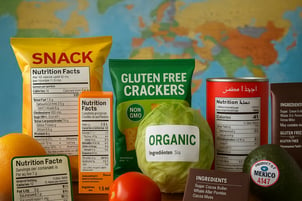Key Differences Between PIM and PLM Systems
Food labels are really important for keeping people safe. They provide essential information like allergy warnings and use-by dates, helping shoppers make informed choices. It is actually required by law for food manufacturers to follow these labelling rules. With the rise in international food trade, it is important to understand both global safety standards and local regulations, along with the certification symbols involved. So, let's dive into why food labelling matters, what the regulations are, and how global safety authorities make sure these rules are followed.
Why Food Labelling and Safety Standards Matter
Proper food labelling enables consumer protection of health, product transparency, and trust in the global food supply chain. Food labelling plays a key role in the time the food is manufactured till the time it is consumed. Accurate labelling improves safety by reducing allergic reactions, guides consumer dietary choices, and is one way of reducing fraud. Proper food labelling also keeps businesses aligned with food safety standards, reducing risks associated with potential legal costs and food recalls.
Global Food Labelling Regulations
Food labels tell a story. Some parts of that story are legally required, others are optional but encouraged.
Mandatory elements usually include:
-
Ingredient lists
-
Allergen warnings
-
Nutritional facts
-
Expiry or “use by” dates
These are non-negotiables in most countries and help consumers make safe and informed choices.
Voluntary elements might include:
-
Health claims (like “low sugar” or “heart healthy”)
-
Sustainability marks
-
Organic or vegan certifications
Even though they are not required by law, these labels often help build brand credibility and appeal to niche consumer segments.
Regional Food Safety Laws and Enforcement Bodies
Food safety laws are essential to prevent the circulation of hazardous goods. Every nation has its own set of laws based on local eating customs, preferred cuisines, risk levels, and scientific studies. Hence, a product accepted in one country could require modifications prior to meeting the standards of another country.
Some of the major authorities overseeing these laws include-
The FDA (U.S. Food and Drug Administration) keeps an eye on food products sold in the States and makes sure that labelling requirements are followed closely.
Over in Europe, the EFSA (European Food Safety Authority) gives advice to EU countries on food-related risks and works to ensure that safety standards are consistent throughout Europe.
In India, the FSSAI (Food Safety and Standards Authority of India) is responsible for setting and monitoring food safety regulations and labeling norms.
The CFIA (Canadian Food Inspection Agency) ensures that food sold in Canada meets safety standards and has the right labelling.
FSANZ (Food Standards Australia New Zealand) is involved in developing food standards.
It is necessary that international food brands comprehend and abide by these local laws. Food imports and exports require labelling modifications, certifications, and compliance with national inspection requirements. Food safety is a business priority, as non-compliance can result in product bans, recalls or legal actions.
Food Certification Symbols: Halal, Kosher, Vegan, Gluten-Free
Certification symbols are more than just little stamps on a label, they are like badges of trust. For many consumers, especially those with dietary restrictions or cultural needs, these certifications are absolutely essential. They provide peace of mind that the product aligns with their values, beliefs, or health requirements.
Halal certification means the food follows Islamic dietary rules, which means it does not have any pork, alcohol, or other forbidden ingredients. Also, everything is prepared in a way that meets halal standards.
On the other hand, kosher labels indicate that the food complies with Jewish dietary laws. This includes specific ways of processing animals, keeping meat and dairy separate, and ensuring all ingredients are pure.
When it comes to vegan certification, it ensures that no animal products or byproducts were used in production, and no animal testing happened. This is especially important for those who are ethical-minded or prefer plant-based options.
As for gluten-free symbols, they show that a product contains less than the legally allowed amount of gluten, which is usually 20 parts per million or less. This is important for people dealing with celiac disease or gluten sensitivity.
Every certification comes from a recognized organization after careful review and auditing, but the criteria can differ by region. For example, something certified as Halal in one country might not meet the standards in another due to local traditions. The same goes for vegan and gluten-free certifications, which are tightly controlled in the U.S. but can be more loosely defined elsewhere.
Another point to clarify is the misconception that these labels mean the product is automatically “healthier.” That is actually not the case, they just confirm compliance with specific dietary standards.
Navigating Cross-Border Labelling and Compliance Challenges
Selling food across different regions can open up new markets, it also brings along a whole bunch of regulatory challenges. One big mistake that brands often make is thinking that a label that meets the requirements in one country will work everywhere else. That is typically not how it goes. Labels often require translation, reformatting, or even a complete redesign to comply with the legal and cultural standards of the country where they're sold. For instance, allergen information, nutritional details, and serving sizes can really differ from one region to another. And then there are health claims. A phrase like “boosts immunity” might be totally acceptable in one place but could be banned in another for being misleading or lacking scientific support.
To stay on the right side of the law, global brands should:
-
Perform regular regulatory checks in all their target markets.
-
Keep thorough records of ingredients, testing, and certifications.
-
Utilize digital labelling tools to quickly and accurately update packaging.
-
Team up with local regulatory experts who know the ins and outs of the landscape.
Getting this sorted out not only safeguards your consumers but also your brand's reputation.
Emerging Trends in Food Labelling and Safety
Food labelling is evolving fast. It is becoming smarter, more transparent, and environmentally conscious.
Smart labels with QR codes are on the rise. These digital tags let consumers scan and access detailed product information, origin, processing methods, nutritional breakdowns, or even allergy alerts. It is a win for both transparency and shelf space.
Sustainability is also taking centre stage. Eco-labels now highlight a product’s carbon footprint, packaging impact, or whether it is ethically sourced. Consumers increasingly want to know not just what’s in their food, but how it affects the planet.
There is also a growing push for global harmonisation of standards. Initiatives like the Codex Alimentarius, developed by the FAO and WHO, aim to set international food safety guidelines. While adoption is still uneven, they help streamline trade and reduce confusion over what’s compliant where.
Conclusion
Food labelling and safety regulations are no longer just back-end compliance tasks, they are central to consumer trust, global trade, and brand integrity. As laws evolve and markets expand, staying updated is essential. Whether you are a small local seller or a global brand, keeping pace with labelling rules, certification processes, and new tech can make the difference between shelf success and regulatory trouble.
Aug 5, 2025 5:34:16 PM








